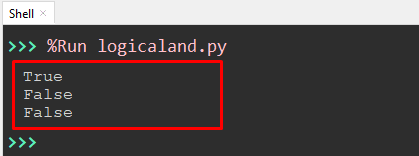In Python, operators are the “symbols” used to execute any logical or arithmetic computation. Different types of operators, such as comparison operator, arithmetic operator, assignment operator, etc., are present in Python. In this article, we will provide a detailed explanation of Python Logical And Operator. The following contents are discussed in this article:
- How Does Logical AND Operator Work in Python?
- Example 1: Simple Logical AND
- Example 2: Logical AND Operator with If Statement
So, let’s get started!
How Does Logical AND Operator Work in Python?
In Python, logical “AND” operators make decisions based on multiple conditions. The logical “AND” operator is applied on a minimum of two conditions representing any Boolean value (true or false). The logical “AND” operator only returns “True” when both the operand conditions are “True” otherwise, it will return “False”.
The syntax of the Logical “AND” operator is shown below:
Operand 1 and Operand 2
Let’s exercise the working of the logical “AND” operator in Python:
Example 1: Checking two Conditions using Logical AND Operator.
In the example given below, the “AND” operator checks the condition and returns the boolean value “True” or “False”.
Code
value_1 = 10
value_2 = 20
print(value_1 > 9 and value_2 < 30)
print(value_1 > 19 and value_2 < 30)
print(value_1 > 9 and value_2 < 10)
In the above code:
- Two variables “vaue_1” and “value_2” are initialized.
- Logical “AND” operators are used in the program to check whether the condition of the left side of the “and” operator is equal to the right side. If both conditions become “True” then “True” is returned otherwise, “False” will be shown in the output.
Output

The output shows the boolean value “True” and “False”.
Example 2: Logical AND Operator with If Else-if Statement
The “AND” operator is also used along with a conditional “If statement” to filter out results. In the example, the working of “AND” with if else-if statement is provided:
Code
value_1 = 40
value_2 = 42
value_3 = 0
if value_1 > value_2 and value_2 > value_3:
print("value_1 is the Greatest Numbers ")
elif value_1 < value_2 and value_2 > value_3:
print("value_2 is the Greatest Numbers ")
else:
print("value 3 is smallest Numbers")
In the above code:
- Three variables are initialized in the program.
- After initialization, the “if” statement is used along with the “AND” operator. If both operand value of the “AND” operator is satisfied, then the statement of code written inside the “if” block will execute.
- The “elif” block statement executes when the“if” condition is not “True”.
- Similarly, the “else” block will execute when both the “if” statement and “elif” statement are not “True“.
Output

In the above output, the “elif” statement executes because both operand values were “True“.
That’s all from this Python guide!
Conclusion
In Python, the logical “AND” operator returns the boolean value “True” when both of the operands are “True”. The logical “AND” operator is used to check multiple conditions at once. The “if statement” is also used with the “AND” operator to filter out the result. This post explained all the details of Python Logical AND Operator with examples.

TUTORIALS ON LINUX, PROGRAMMING & TECHNOLOGY